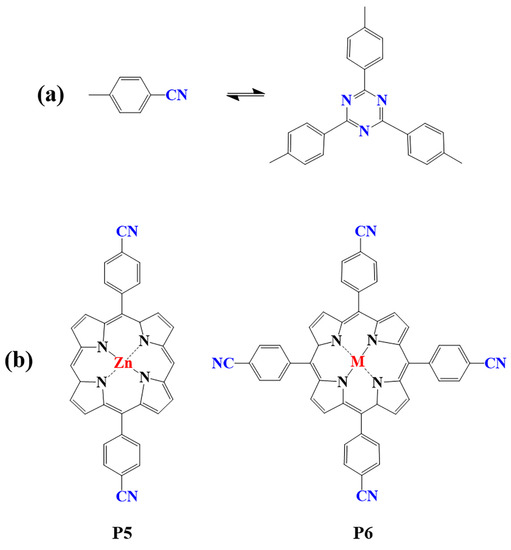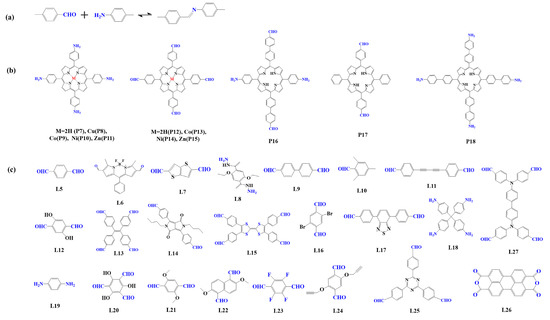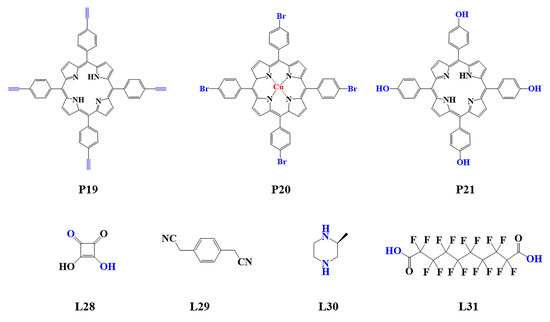You're using an outdated browser. Please upgrade to a modern browser for the best experience.
Please note this is a comparison between Version 1 by Shengjie Wang and Version 2 by Conner Chen.
Chemical modification and self-assembly of molecules as well as constructing porphyrin-based metal (covalent) organic frameworks are often used to improve its solar light utilization and electron transfer rate. Especially porphyrin-based covalent organic frameworks (COFs) in which porphyrin molecules are connected by covalent bonds combine the structural advantages of organic frameworks with light-capturing properties of porphyrins and exhibit great potential in light-responsive materials.
- bio-inspired
- porphyrin-based COFs
- photoelectric conversion mechanism
1. Introduction
Overreliance on fossil fuels leads to growing energy crises and environmental problems. It is imperative to develop clean and renewable energy, such as solar energy, instead of traditional fossil fuels. Organisms, including green plants and certain microorganisms, show great skill in solar energy utilization, in which solar energy is converted to chemical energy and stored in carbohydrates. Inspired by natural photosynthesis, photocatalytic conversion for solar water splitting and CO2 reduction to produce hydrocarbon fuels has been considered one of the most promising ways to solve the increasingly serious energy and environmental problems [1][2][3][4][1,2,3,4]. Since photocatalyst plays a pivotal role in the photocatalysis reaction, the design and preparation of highly efficient photocatalysts are important to improve solar energy utilization and photoelectric or photochemical conversion efficiency. An excellent photocatalyst requires not only light response in a wider wavelength range and high light absorption coefficient but also high photoelectric conversion and separation/transfer efficiency of charge carriers in the same substance and interface, appropriate electronic energy level, and redox gradient [5][6][5,6].
Since Fujishima and Honda first reported the photocatalytic decomposition of water on TiO2 electrodes in 1972 [5], many types of photocatalysts, including inorganic and organic photocatalysts, have been explored [7][8][9][10][11][12][13][14][15][16][17][18][19][20][21][22][23][7,8,9,10,11,12,13,14,15,16,17,18,19,20,21,22,23]. Inorganic semiconductors represented by metal oxides such as TiO2 have the virtues of high stability and low price. However, certain inherent defects, such as wide band gap and mismatch of conduction/valence band position, result in poor visible light utilization and low quantum yield, which limit their photocatalytic performance [16][24][25][26][27][16,24,25,26,27]. Different from inorganic semiconductors, organic photocatalysts have abundant structural units and flexible designability. For example, plants show excellent solar light utilization dependent on the light-capturing ability of chlorophyll. As is known, chlorophyll is a derivative of porphyrin, and its large conjugated heterocyclic structure endows it with excellent photosensitivity. At the same time, nitrogen atoms in the porphyrin ring can coordinate with different metals. Such unique structures give them high versatility and adjustability [28][29][28,29]. Inspired by natural photosynthesis, it is expected to obtain stable and efficient photocatalysts by introducing porphyrin compounds into the photocatalytic system [30][31][30,31].
However, the intrinsic gap between the B and Q bands of porphyrin monomers locates in the strongest output range of the sun’s total irradiance spectrum (450–550 nm), which limits their light-capturing ability. Meanwhile, low charge carrier separation and transmission efficiency limit the development of porphyrin-based photocatalytic systems [32][33][32,33]. Chemical modification or combination with other dyes can improve their absorption in the visible light region. As is known, aggregation of porphyrin molecules can change their light absorption behavior. H-aggregation (face-to-face) leads to the blue shift, while J-aggregation results in the red shift. Therefore, an alternative method for changing the spectral properties is to regulate their aggregation state. J-aggregation of porphyrin leads to the red shift of the absorption maximum to the higher energy region of sunlight. Moreover, the J-aggregation of porphyrin allows the photogenerated electrons to spread over the J-aggregates [34][35][36][37][38][39][40][41][42][34,35,36,37,38,39,40,41,42]. Many efforts had devoted to constructing porphyrin J-aggregates, and we know that their photocatalytic ability can be improved by introducing structural regulatory reagents [31][43][44][45][46][47][31,43,44,45,46,47], replacing or modifying peripheral groups [48][49][50][51][48,49,50,51], complexing [52][53][52,53], choosing solvents appropriately [54][55][54,55], or changing the properties of solution [56][57][58][59][56,57,58,59]. Unfortunately, the J-aggregates of porphyrin are vulnerable to environmental conditions such as pH and ionic strength because most J-aggregates are stabilized by intermolecular electrostatic interactions. Additionally, defects in the aggregates limit the delocalization of photoinduced electrons and result in lower transfer efficiency. Therefore, more efforts are needed to construct stable and efficient porphyrin-based photocatalytic systems.
Compared to the porphyrin J-aggregates stabilized by electrostatic interactions, porphyrin-based polymers connected by covalent bonds are expected to be more stable. Especially for those connected with conjugated bonds, the conjugate structure allows the photoinduced electrons to delocalize along the polymer chain, which improves the transport rate of carriers. Porphyrin-based covalent organic frameworks (COFs) possess highly conjugated structures and π-π packing and unique performances in electron transport by regulating the porphyrin units at the molecular scale [60][61][60,61]. At the same time, the material has functional designability and structural controllability, easy to adjust and optimize the band structure and surface property of porphyrin-based COFs at the molecular level, thus enabling efficient light absorption and charge separation [62][63][64][65][62,63,64,65]. Corresponding to their ordered structure, porous nature, and functional construction units, porphyrin-based COFs have widespread applications in gas storage/separation [66][67][66,67], catalysis [68][69][68,69], sensing [70][71][70,71], energy storage [72][73][72,73], and phototherapy [74][75][74,75].
The construction of porphyrin-based COFs using porphyrins as the light-capturing units provides a unique solution for the stable and efficient porphyrin-based photocatalytic system and exhibits great potential in photocatalytic degradation of organic pollutants, hydrogen production, inhibition of bacteria, and other aspects [62][76][77][78][79][62,76,77,78,79]. Through molecular design and incorporation of special functional groups, porphyrin-based COFs can be used in biomedical fields such as photodynamic therapy and photothermal therapy, indicating great values of porphyrin-based COFs in the conversion and utilization of light.
2. Molecular Design of Porphyrin-Based COFs
As photocatalysts, light absorption capacity, separation, and transport of photogenerated charge carriers are important to their photocatalytic properties. In porphyrin-based COFs, porphyrin groups linked in the form of covalent bonds can improve their stability, crystallinity, and catalytic activity during photocatalysis [80]. In addition, appropriate orbital energy levels and band gaps can be obtained by regulating porphyrin units, organic ligands, and conjugate bonds. Therefore, porphyrin-based COFs will be expected to have both excellent light-harvesting ability and efficient charge separation and transport behavior. Interestingly, the introduction of a donor–acceptor (D–A) pair into the conjugated structures can further enhance light capture and facilitate the separation of photogenerated charges [80]. Two key issues should be considered during the design and synthesis of porphyrin-based COFs: the first is the design of the building blocks, namely the structure of the building blocks and connection mode. The second is the synthesis method, which determines if the desired frameworks can be obtained [81][82][81,82].
2.1. Construction of Porphyrin-Based COFs
The preparation of porphyrin-based COFs is similar to those of other COFs. Borate condensation reaction (Figure 1a), triazine condensation reaction (Figure 2a), and imine condensation reaction (Figure 3a) are often used to construct porphyrin-based COFs [83]. The involved reactions are reversible and thermodynamically controlled [84][85][84,85]. There are error-checking and self-healing processes during the formation of the reversible covalent linkages [86][87][88][86,87,88], resulting in ordered and thermodynamically stable porphyrin-based COFs [89][90][89,90]. Additionally, other reactions, including the Yamamoto homo-coupling reaction [91], cubic acid amino condensation reaction [92], and a pot of esterification reaction [93], had been used to prepare porphyrin-based COFs (Figure 4).

Figure 1. (a) Schematic illustration of borate-linked porphyrin-based COFs; (b) Frequently used monomers containing boron hydroxyl and (c) phenolic hydroxyl groups.

Figure 2.
(
a
) Schematic illustration of triazine-linked porphyrin-based COFs; (
b
) Frequently used monomers.

Figure 3. (a) Schematic illustration of imine-linked porphyrin-based COFs. (b) Frequently used monomers containing amino and (c) aldehyde groups.

Figure 4.
Monomers used in the synthesis of porphyrin-based COFs.
2.1.1. Construction of Borate-Linked Porphyrin-Based COFs
As a common reaction in organic synthesis, borate bonds generated from the condensation of borate acid and catechol derivatives are widely used to construct porphyrin-based COFs (Figure 1a). For example, porphyrin monomers containing p-dihydroxy boron (P1) and tetra-dihydroxy-beryl groups with different core structures (P2–P4) are condensed with 1, 2, 4, 5-tetrahydroxy benzene (L1–L4) to construct a series of borate porphyrin-based COFs [94][95][96][97][94,95,96,97]. Such porphyrin-based COFs with B–O linkages showed high crystallinity, special pore size, and large surface areas. However, compared to the porphyrin-based COFs linked by imine and triazine bonds, the COFs with borate-linkage are less stable in acidic and basic aqueous solutions, which limits their application in photocatalysis to some extent [83].
2.1.2. Construction of Triazine-Linked Porphyrin-Based COFs
Porphyrin-based covalent triazine frameworks are formed by cyclotrimerization of porphyrin monomers with nitrile groups (Figure 2a). The strong aromatic group in the triazine unit and ring fusion of C=N bonds endow them with high chemical stability. However, these porphyrin-based COFs are usually amorphous and lack long-range molecular orderings due to the nonplanar trimerization route [98]. In addition, only limited members of triazine porphyrin-based COFs were reported due to the lack of suitable monomers (P5, P6) [83][99][100][101][102][103][83,99,100,101,102,103].
2.1.3. Construction of Imine-Linked Porphyrin-Based COFs
Imine condensation reaction (Schiff base reaction) is the most widely used reaction in the synthesis of COFs, which is formed by the condensation of the amino group and aldehyde group (Figure 3a) [83]. The reaction is reversible, and it is easy to form a regular and ordered crystalline structure in COFs. In 2011, Yaghi et al. [95] synthesized the first imine bond-linked porphyrin COFs (COF-366) by the condensation of 5, 10, 15, 20-tetrad -(4-(amino) phenyl)-porphyrin (TAPP, P7) with p-phenyl formaldehyde (L5) under solvothermal condition, in which the carrier mobility reached 8.1 cm2 V−1 s−1. From then on, researchers prepared various imine bond-linked metal porphyrin-based COFs [104][105][106][104,105,106] by using different metal porphyrin monomers. The results showed that their photophysical and electronic properties could be regulated by the core metal ions. At the same time, to construct photocatalysts with high photocatalytic performance, researchers prefer to select monomers with electron-donating or accepting properties [62][107][108][62,107,108].
2.2. Synthesis of Porphyrin-Based COFs
The synthesis methods, structures, and properties of porphyrin-based COFs are dependent on the adopted preparation procedures. Till now, several synthetic methods, including solvothermal, microwave synthesis, and ionothermal methods, have been adopted to prepare porphyrin-based COFs. Among them, the solvothermal method is most widely used because of its high degree of universality [109]. Regular COFs were produced through the process of dissolution and recrystallization of raw materials in a closed pressure vessel at a certain temperature [86]. Great efforts have been made to optimize the synthesis conditions for the preparation of high-quality COFs. The crystallinity of porphyrin-based COFs is very sensitive to the reaction conditions. Therefore, their crystal state, morphology, pore size distribution, and other properties would be related to solvent, catalyst, temperature, reaction time, pressure, and other reaction parameters [110][111][112][110,111,112]. At the same time, the intrinsic relationship between the structure and property also attracted considerable attention and was usually used to direct the regulation of their photocatalytic properties [83][90][83,90].
Microwave synthesis showed several advantages over solvothermal methods, such as high reaction speed, high heading efficiency, and well-distributed heating [113], resulting in the formation of cleaner products with higher yields within less time. Compared to traditional thermal-assisted methods, microwave-assisted methods have the advantages of easy control, fast kinetic energy speed, high heating efficiency, and fast and uniform heating rate [114], which is conducive to obtaining COFs with high purity. The ionothermal method refers to the cyclization trimerization reaction in ZnCl2 at 400 °C using a nitrogen heterocyclic ring as the basic element [100]. The reaction is only partially reversible, resulting in less crystallinity. Moreover, harsh reaction conditions are usually required, which narrows the scope of porphyrin-based COFs.
